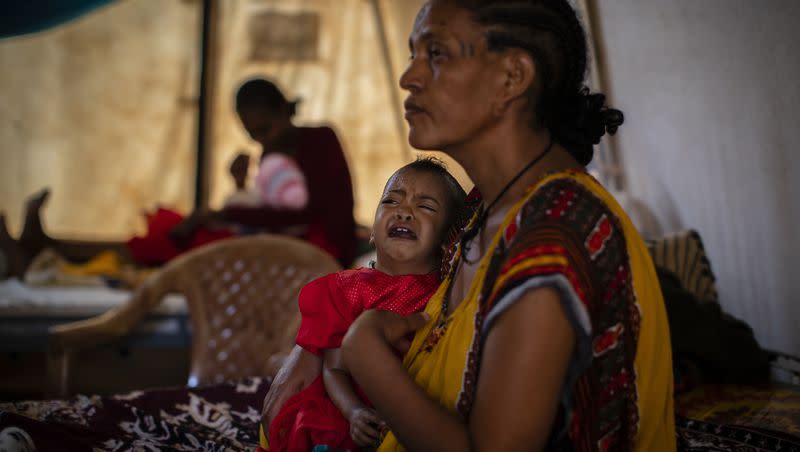When peace talks don’t actually bring peace in Ethiopia

When peace talks between the Ethiopian government and the fighters in Tigray were concluding late last fall, a young woman told the BBC she spent the night hiding from her Eritrean rapists under a bridge in northeast Tigray. In other villages east of the town of Adwa, The Washington Post reports that Eritrean soldiers were going door-to-door shooting civilians, apparently in retaliation for a recent battlefield loss.
Eritrea, Ethiopia’s northern neighbor, joined Ethiopian forces to wipe out what they called a rebellion in Tigray, but did not participate in the peace process. Despite a United Nations human rights report detailing crimes against humanity and war crimes, there has been no accountability process put into place. In fact, when Eritrea’s President Isaias Afwerki was asked about the abuses on a recent visit to Kenya, he dismissed all claims. According to the BBC, he said “Everybody talking about human rights violations (by Eritrean forces), rape, looting, this is a fantasy in the minds of those who own this factory, that I call a factory of fabricating misinformation.”
The BBC, the United Nations and multiple human rights organizations have documented ongoing sexual assaults on Tigray women, including some so violent they caused their victim to become incontinent of urine. According to data from the official Tigray Health Bureau in November and December 2022 — after the peace deal was signed — 852 cases were reported to rape crisis centers. However, aid workers believe that many instances of sexual violence continue to go unreported.
A news source out of Israel, YNetNews, reports that Ethiopian women are being trafficked to neighboring countries like Jordan. Some have been able to escape to Israel, where local refugee organizations have been helping the survivors.
Related
The Washington Post investigated reports of Eritrean soldiers going door-to-door and massacring civilians as peace talks were underway in the Ethiopian capitol of Addis Ababa. There they found accounts of more than 300 victims being killed. After the Tigrayan troops withdrew from the village of Mariam Shewito, for example, the villagers were left unprotected. Eritrean soldiers shot 92-year-old Gebremariam Niguse, then killed his son, two daughters, a son-in-law, daughter-in-law and 15-year-old granddaughter. Survivors told The Washington Post that soldiers had ordered the daughter-in-law to untie her 5-month-old baby from her back, then shot her in front of her five sons, ages 10 and younger.
In the village of Kumro, The Washington Post reports 35-40 villager deaths. In Endabagerima, another 80. Almost 50 villagers killed in Geria, while Mariam Shewito had at least 140 victims.
It is no wonder then, that a request by Ethiopia to cut short U.N. inquiries into war atrocities in the region has been met with alarm. Human Rights Watch published a letter last week, expressing concern about Ethiopia’s plans to introduce a motion to end the commission probing the war in Tigray region. Sixty-three human rights groups have signed on as well. The letter reads in part:
Ethiopia’s attempts to terminate ICHREE’s mandate during its term are unprecedented. Not only does it suggest that states can politically maneuver to overturn the decisions of the Human Rights Council to avoid independent scrutiny and accountability, but it could also set a dangerous precedent regarding international scrutiny and impunity for rights abuses elsewhere.
Meanwhile this week, the executive director of U.N. Women, Sima Bahous, spoke during a U.N Security Council meeting and criticized the lack of female representation in peace talks. Academic research by Marie O’Reilly, Andrea Ó Súilleabháin, and Thania Paffenholz has already shown that when women are at the negotiating table, the peace agreement reached is 35% more likely to last at least 15 years. Desirée Nilsson’s research from 2012 found that when civil society groups, including women’s organizations, are involved in making a peace agreement, it is 64% less likely to fail than if they are not involved. In 2006, the former Secretary-General of the United Nations, Kofi Annan, said that the world was starting to grasp that the empowerment of women and girls was the most effective policy in promoting state development, health and education, and further, he said, “I would venture that (there) is no policy more important in preventing conflict or in achieving reconciliation after a conflict has ended.”
And. yet this week, as Bahous noted, there has been no significant change in the composition of those negotiating peace, nor has there been any change in the “impunity enjoyed by those who commit atrocities against women and girls.”
If peace is to actually be peace, we need, as Bahous argued, a “radical change in direction.”
Holly Richardson is the editor of Utah Policy, a weekday newsletter about the people, policies and politics affecting Utahns.

